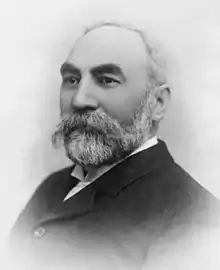Louis Zeckendorf
Louis Zeckendorf (April 6, 1838 – March 11, 1937) was a Jewish German-born American merchant. He was primarily involved in the mining industry in New Mexico and Arizona, as well as shipping and supplies in support of that industry.

Biography
Zeckendorf was born in Hanover, Germany on April 6, 1838.[1] After growing up in Hanover, in 1854 he immigrated to Santa Fe, New Mexico, to join his brother Aaron,[2] with his younger brother William joining them a year later.[3] Louis and Aaron became members of the historical society, with Aaron being a charter member.
They founded their first store with financial support from the Spiegelbergs, their former employers. Under the banner of A. & L. Zeckendorf, Wholesale and Retail, Aaron opened a Santa Fe branch, and Louis opened one in Albuquerque (an additional branch was opened in Deming, and stores near mining camps along the Rio Mimbres).[4] The store was moderately successful; but suffered a downturn in business at the start of the Civil War. When the South invaded New Mexico, their businesses suffered heavy taxes, as they were loyal to the Union, and their brother William was an officer in the Union army. Their success was renewed when the southern troops were driven out of New Mexico.[2]
In 1865, heavy snow in the Raton Mountains caused them to lose a large amount of dry goods. In 1866, Louis sold $50,000 worth of goods to Charles T. Hayden. Upon improved business prospects, he went to New York City, and established a purchasing branch of the company in 1867.[2] The brothers hired their nephew, Albert Steinfeld in 1872 After his older brother Aaron died in 1872, Louis sold his share of the business to William and a brother in law, Theodore Welisch. The partnership soon failed, and Louis reluctantly partnered with his younger brother, William, to form Zeckendorf brothers.[4] When Louis bought William's share of the business in 1878, he reformed the business with his nephew, Albert Steinfeld to create L. Zeckendorf & Company.[1] By 1889, their Tucson business was the largest retail and wholesale merchandising business in the Arizona Territory. He sold furniture to the Santa Rita Hotel.[5] At its peak, the company had $1.5 million in annual revenue (about 49 million dollars in 2022).[4]
Louis was also one of the founding members of the Copper Queen Mining Company. He gained the rights to freighting supplies and equipment into Mule Gulch, and the rights to shipping ore and bullion westward. In addition, Louis was the first treasurer of the company and also served as a secretary and manager.[6] Louis also invested in the Ray mine, heavily in silver and gold mining in Montana and the Silver Bell mine.[7]
Around 1872, William's wife, Julia Zeckendorf had become owner of the Old Boot mine. William asked his nephew to become a trustee of the mine, and he agreed. In 1897, he leased the mine to Carl S. Nielsen. Nielsen was allowed to mine and smelt ore, providing he bought supplies from L. Zeckendorf and Co., and paid a royalty of $1.25 a ton. After six months, Nielsen was $16,000 in debt. On January 14, 1899, a subsidiary of L Zeckendorf and Co, Nielsen Mining & Smelting Corporation was founded to manage the Old Boot mine. James Curtis was appointed to oversee the operation. The endeavor quickly lead to a rift in the relationship between Louis and Albert, and in November 1902, Louis announced his intention to leave the partnership in May 1903. In April, the Imperial Copper Company of Arizona agreed to buy the mine for about $515,000 (roughly 18 million dollars in 2022). Louis filed suit over money he believed had been defrauded from him, and the subsequent lawsuit eventually made its way to the Supreme Court of the United States, first in the 1912 term and again in the 1915 term, with the Court ultimately deciding in Louis' favor.[4]
Louis' involvement in the company ended in 1904, When Albert bought his share of the company. At the end of Zeckendorf's involvement in the company, The Tucson Citizen wrote that "the great name of L. Zeckendorf & Co. is no more." For thirty-five years, it had been "synonymous with enterprise, business sagacity and sterling integrity throughout the commercial world of Arizona and Northern Sonora, Mexico."[4]
He married Matilda Z. Leventritt on December 23, 1870. Their union produced a son: Aurthur Louis.[1] He died in New York City on March 11, 1937.[8]
References
Footnotes
- McFarland & Poole 1896, p. 531.
- Chapman Publishing Co. 1901, p. 531
- Fierman 1981, p. 389
- Lyons 2000
- Arizona Daily Star, Santa Rita Hotel Opens to the Public, Feb 2, 1904
- Grasse, David (2017-04-07). The Bisbee Massacre: Robbery, Murder and Retribution in the Arizona Territory, 1883–1884. McFarland. p. 17. ISBN 978-1-4766-6731-7.
- Burton, Clarence Monroe; Stocking, William; Miller, Gordon K. (1922). The City of Detroit, Michigan, 1701–1922. Clarke Publishing Company. p. 183.
- Lyons 2000, p. 176.
Bibliography
- Portrait and biographical record of Arizona. Chicago: Chapman Publishing Co. 1901. OCLC 247520194.
- Fierman, Floyd S. (Winter 1981). "The Spectacular Zeckendorfs". The Journal of Arizona History. Arizona Historical Society. 22 (4): 387–414. JSTOR 41695625.
- Grytz, Gerhard (Fall 2006). ""Triple Identity": The Evolution of a German Jewish Arizonan Ethnic Identity in Arizona Territory". Journal of American Ethnic History. University of Illinois Press. 26 (1): 20–49. JSTOR 27501779.
- Lyons, Bettina (Summer 2000). "MR. STEINFELD IS IN SOLE CONTROL: The Celebrated Case of Louis Zeckendorf vs. Albert Steinfeld and the Silver Bell Copper Company". The Journal of Arizona History. Arizona Historical Society. 41 (2): 149–180. JSTOR 41696565.
- A Historical and Biographical Record of the Territory of Arizona. Chicago: McFarland & Poole. 1896. OCLC 4074521.